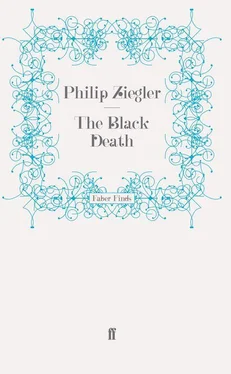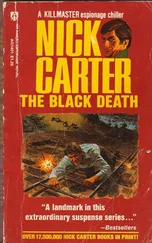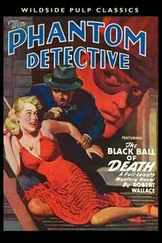12. THE WELSH BORDERS, WALES, IRELAND AND SCOTLAND
BUT while the Black Death had thus moved northwards to the Scottish border, Wales and the adjoining British counties had not been spared. From Bristol the plague had spread into Worcestershire, rising to its crescendo in June 1349; then dying away in August only to return in the late autumn. {379} As early as April it had proved necessary to forbid further burials in the cathedral churchyard at Worcester because the congestion of the dead was beginning to threaten the survival of the living. {380}
‘Alas,’ recorded the Bishop,
the burials have in these days, to our sorrow, increased… (for the great number of the dead in our days has never been equalled); and, on this account, both for our brethren in the said church ministering devoutly to God and His most glorious Mother, for the citizens of the said city and others dwelling therein, and for all others coming to the place, because of the various dangers which may probably await them from the corruption of the bodies, we desire, as far as God shall grant us, to provide the best remedy. {381}
The Bishop’s remedy was to open a new graveyard beside the hospital of St Oswald and transfer there not only all burials which would otherwise have been in the Cathedral cemetery, but also from several of the parish churches of Worcester as well. ‘Hence’, in the lapidary phrase of a local historian, ‘that prodigious assemblage of tumulation which, at this time, cannot be viewed with indifference by the most cursory beholder.’ {382}
Bishop Wulstan Bransford himself remained secluded in his manor at Hartlebury, four miles south of Kidderminster. In spite of this precaution he died on 6 August 1349. The King’s Escheator reported on the state of his estates between early August when he died and late November when a successor was appointed. His record shows that Hartlebury was not an isolated case. Tenants, he said, could not be got at any price; mills were vacant, forges standing idle, pigeon houses in ruins with all the birds fled. Of £ 140 owing to the Bishop in cash or in the form of various feudal services, £ 84 were never received, ‘…on account of the dearth of tenants, who were wont to pay rent, and of customary tenants, who used to perform the said works, but who all died in the deadly pestilence’. As late as 1354 relief was still being sought on the grounds that it was impossible for the Bishop to obtain any of the customary services which had once been his due; ‘…the remnant of the said tenants had changed them into other services and, after the plague, they were no longer bound to perform services of this kind’.
Some time in 1349 a serious riot took place between the townsmen and the monks of the Priory of St Mary, the Cathedral monastery. The townsmen broke down the gates of the priory, chased the prior ‘with bows and arrows and other offensive weapons’ and tried to set fire to the buildings. Here, as in the somewhat similar incident at Yeovil, {383} it is tempting to see some link with the Black Death. Certainly such a possibility cannot be excluded. But chasing the prior with bows and arrows and other offensive weapons was by no means unheard of in Worcester. Relations between town and cathedral monastery were often strained in medieval England and, though the Black Death may have heightened the tension, there is no reason to believe that in Worcester or elsewhere it actually created it.
Bishop Trilleck’s neighbouring diocese fared no better. In Hereford the Bishop forbade the acting of ‘theatrical plays and interludes’ in the city churches, a belated attempt to avert the wrath of the Almighty which seems to have met with little success. In the end, it is claimed, the epidemic was checked ‘by carrying the shrine of St Thomas of Cantilupe in procession’. In 1352 a joint petition was lodged by the patrons of the two churches of Great Colington and Little Colington: {384}
the sore calamity of pestilence of men lately passed, which ravaged the whole world in every part, has so reduced the number of the people of the said churches and for that said reason there followed, and still exists, such a paucity of labourers and other inhabitants, such manifest sterility of the lands, and such notorious poverty in the said parishes, that the parishioners and receipts of both churches scarcely suffice to support one priest.
The Bishop saw the justice of the complaint and the two parishes were duly amalgamated.
The county historians illustrate the impact of the plague by quoting the inquisition post-mortem on the family of John le Strange of Whitchurch. {385} John died on 20 August, when the plague had already done its worst over most of the county. He left three sons: Fulk, Humphrey and John the younger, of whom Fulk, as eldest, was naturally the heir. By the time the inquiry was held on 30 August, Fulk had already been dead two days. Before an inquisition could be held on Fulk’s estate, Humphrey too was dead. John, the third brother, survived but inherited a shattered estate. Even before his father died the three water mills ‘which used to be worth twenty marks’ had been reassessed at only half the value, ‘by reason of the want of those grinding, on account of the pestilence’. In another of his manors, ‘two carucates of land which used to be worth yearly sixty shillings’ were held to be worth nothing ‘because the domestic servants and labourers are dead and no one is willing to hire the land’.
Cheshire, to the north, was thinly populated in the fourteenth century but there is plenty of evidence to show that the losses were still severe. The heads of three of the largest religious houses – the abbot of St Werburgh’s, the prioress of St Mary’s, Chester and the prior of Norton – all died within a few weeks of each other. It was impossible to find anyone able and willing to hold the eyre of the forest, the bridge over the Dee remained out of repair for several months, the income gained from tolls at the passage of Lawton dropped away to little more than half its former value. The increased bargaining power which the Black Death put into the hands of the surviving tenants is well illustrated by the case of the manor of Rudheath, between Northwich and Macclesfield. A note on the Court Roll reads: {386}
In money remitted to the tenants… by the Justices of Chester and others, by the advice of the Lord, for the third part of their rent, by reason of the plague which had been raging, because the tenants there wished to depart and leave the holdings on the Lord’s hands unless they obtained this remission until the world do come better again, and the holdings possess a greater value… £ 10 13s. 11¾d.
It would be interesting to know more about the status of the tenants. The Government was shortly to pass legislation seeking to prevent the migration even of free tenants but it would not be surprising if the tenants of Rudheath in fact enjoyed no legal right to quit their tenements and were blackmailing their landlord with a threat to commit an unlawful act. Certainly such a case would not have been unique. The knowledge that the law was on his side was small comfort to a lord whose tenants had escaped and were now working on some neighbouring estate, enjoying more favourable terms and sheltered by their new master who, however he might deplore their breach of the feudal laws, was still primarily interested in ensuring that his own houses were lived in and his own lands were tilled.
* * *
Mr Rees, the leading authority on the Black Death in Wales, has recorded the lament of the contemporary Welsh poet, Jeuan Gethin, who must have seen and described the plague in March or April of 1349: {387}
We see death coming into our midst like black smoke, a plague which cuts off the young, a rootless phantom which has no mercy for fair countenance. Woe is me of the shilling in the arm-pit; it is seething, terrible, wherever it may come, a head that gives pain and causes a loud cry, a burden carried under the arms, a painful angry knob, a white lump. It is of the form of an apple, like the head of an onion, a small boil that spares no one. Great is its seething, like a burning cinder, a grievous thing of an ashy colour. It is an ugly eruption that comes with unseemly haste. They are similar to the seeds of the black peas, broken fragments of brittle sea-coal and crowds precede the end. It is a grievous ornament that breaks out in a rash. They are like a shower of peas, the early ornaments of black death, cinders of the peelings of the cockle weed, a mixed multitude, a black plague like halfpence, like berries. It is a grievous thing that they should be on a fair skin.
Читать дальше












